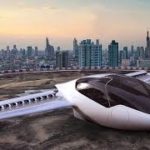How luring does it seem if there is a possibility of being commuting to and from work within a fraction of the time it usually takes?
More on there will be no traffic jams, no cold platforms, and no train delays – seems like you are ready to say a quick yes.
Well, the time is not far away as more than a hundred companies have undertaken the development of electric vertical take-off and landing (eVTOL) aircraft.
Similar to helicopters, they don’t need a runway but dissimilar from helicopters as they promise to be cheap and quiet.

Volocopter’s Airtaxi
However, there is still some time until the dream comes true. Industry specialists say that taxi services using such aircraft won’t be an economic phenomenon until the 2030s.
So what is the holdup?
Capable of flying far away?
There are enough reasons why the eVTOL industry is aiming at short hops in and out of cities.
Firstly, there are ample of potential customers in cities; secondly, eVTOL aircraft can’t hover very far.
Most have batteries that can let them fly for around half an hour. In the case of Germany’s Volocopter, this sums to a range of about 22 miles (35km) with a maximum velocity of around 68mph (110km/h).
It made a test flight above Singapore’s Marina Bay.

Other companies have increased range by adding wings. Thus companies like Germany’s Lilium have an aircraft that can take off vertically but can also bend its wings and engines and fly similar to a regular plane. Lilium anticipates its aircraft to have a range of 185 miles (300km).
Vertical Aerospace in the UK is also at work on eVTOL with wings that it hopes will fly more than 100 miles.
YOU MAY LIKE: 3 Flying Cars You Can Order Now
But the industry would still eagerly await to see a breakthrough in battery technology, which would make all these prototypes much more beneficial aircraft.
Air taxi landing and take off
If you are planning an air taxi service then you need someplace suitable for your aircraft to land or take off and also charge or switch their batteries – what the industry likes to name “vertiports.”
However it is accompanied by several challenges.
In big cities, space is already inadequate. Heliports already exist but might not be preferably located or able to handle extra traffic.
Some buildings might have suitable rooftops, but they are likely to be costly to use.
Even if sites are known, they would still need to conform with planning guidelines, which don’t even exist yet.

One of the big marketing points of eVTOL aircraft is that they are comparatively quiet. While hovering, they should make just a fraction of the sound of a helicopter, according to Michael Cervenka, a senior manager at Vertical Aerospace.
And while flying frontward, “you wouldn’t hear them at all,” he adds.
So that might relieve the concerns of those living near a vertiport, but you could still picture people complaining of a continuous stream of air traffic.
And only one accident might create general opposition to having landing zones in densely populated areas.
Safety
Aviation controllers in the US and Europe are currently working out the principles they want these new aircraft to meet.
Once decided, an eVTOL aircraft is likely to go through years of experimenting before it meets them, a process likely to charge hundreds of millions of pounds.
“Most eVTOL producers I have been talking to are trying to get certification by 2023,” says Darrell Swanson, who runs his own consultancy specializing in the eVTOL industry.
In their favor, electric aircraft are much simpler than helicopters or passenger jets, so automatically, there is hardly anything to go wrong.
“We don’t need great big gearboxes and tools like that,” says Steve Wright, an avionics professional at the University of the West of England.
Many aircraft models have numerous motors, so they can fly even if one engine misses the mark.

Uber, which has an eVTOL venture called Uber Air, says that flying taxi services only have to be safer than driving a car, maybe twice as safe.
But the regulators and public might expect safety standards nearer to those of airlines.
Another query that has not really been answered is how eVTOL aircraft will operate in bad weather.
To reduce weight, they will be very light, which could make flying in windy situations, dangerous or bumpy.
Yet a taxi service that has to close its operations on a windy day would not be much use in many countries in the world.
Monitoring the aircraft
Air traffic control systems already observe the activities of helicopters over cities and experts says those systems could probably handle hundreds more eVTOL aircraft.
Many big cities have rivers flowing through the middle, which – with no inhabitants below – make perfect flight paths.
But if eVTOL is going to turn into a commercial transport system, with thousands of aircraft, then new airspace controlling systems will have to be put in place.

That will undoubtedly be the case if the industry meets its ultimate goal – aircraft sans pilots.
Those aircraft themselves will be able to detect what is going on nearby them and identify other aircraft.
“It’s not like all of a sudden we are going to have 5,000 vehicles hovering over London on 1 January 2023,” says Mr Swanson.
“There’s going to be a gradual buildup of traffic over time and that will let us prove these systems work appropriately.”
Cost
The business sample of a flying taxi service is yet to be worked out. But they will likely cater short, precise routes in and out of cities.

Uber Air considers that such services will become “an inexpensive form of daily transportation for the masses, even less costly than owning a car.”
Though, to begin with, such services will aim richer customers who are ready to pay a premium.
“It’s the same longstanding story, there will be early adopters with loads of money who will pay over the odds,” says Mr Wright.
“The leap from the top of an affluent area in the City of London out to Heathrow or somewhat like that would be extremely useful.”



[…] Read: The Competition To Build A Flying Electric Taxi […]
[…] YOU MAY LIKE: The Competition To Build A Flying Electric Taxi […]